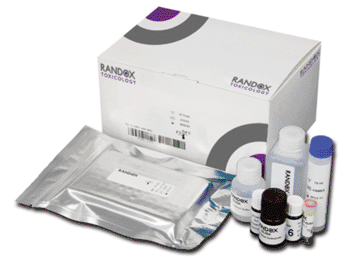Mitragynine ELISA Detects Designer Drug
By LabMedica International staff writers
Posted on 17 Apr 2013
A designer drug originates from Mitragyna speciosa, an uncontrolled plant found in South East Asia. Posted on 17 Apr 2013
Called Kratom, the drug has become more popular because it is easily available on the internet and in head shops [shops specializing in paraphernalia used with or related to illegal drugs]. It is marketed as a means to combat fatigue, pain, and depression. A new immunoassay for Kratom was developed by Randox Toxicology (Crumlin, United Kingdom) and provides a rapid solution for the detection of Mitragynine and its metabolites.

Image: Solutions for Drugs of Abuse Testing (Photo courtesy of Randox Toxicology).
From exotic plants to synthetic blends, designer drugs are problematic for forensic toxicologists as waves of new compounds with differing chemical properties quickly flood the market. Immunoassays provide a straightforward method for laboratory drug screening, allowing a large number of specimens to be screened relatively quickly. A novel ELISA developed by Randox Toxicology can detect Mitragynine and its metabolites; 9-O-Desmethylmitragynine, 7-alpha-Hydroxymitragynine and 7-alpha-Acetoxymitragynin in urine and blood specimens, providing valuable information for further analysis.
The Randox Toxicology enzyme-linked immunosorbent assay (ELISA) can detect Mitragynine and its metabolites; 9-O-Desmethylmitragynine, 7-alpha-Hydroxymitragynine, and 7-alpha-Acetoxymitragynin in urine and blood specimens, providing important information for further analysis.
As with other designer drugs such as “Spice” and “Bath Salts,” Kratom is marketed as a “legal high,” which can mislead users to believe that the drug is safe to use. Several cases of psychosis resulting from the use of Kratom have been reported, with individuals addicted to the drug exhibiting psychotic symptoms such as hallucinations, delusion, and confusion. Mitragynine and several related alkaloids naturally occur in the Mitragyna speciosa plant, creating psychoactive properties.
Randox Toxicology, through its research and development capabilities, is able to quickly develop reliable assays for designer drugs. The company has developed a range of rapid immunoassays on ELISA and Biochip arrays, including Synthetic Cannabinoids and Synthetic Cathinones, commonly referred to as “Bath Salts.”
Related Links:
Randox Toxicology










 (3) (1).png)



